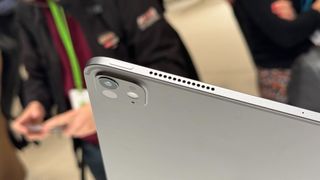Early Verdict
The surprise introduction of M4 joins a new OLED display to make the iPad Pro better than its ever been before — and primed for an AI power surge.
Pros
- +
M4 chip
- +
Stunning OLED display
- +
Thinner than ever before
Cons
- -
Accessories aren't backwards compatible
- -
High asking price
You can always trust iMore.

- Let Loose event LIVE — Everything announced at the Let Loose event, as it happens
- OLED iPad Pro — M3 and a major display upgrade expected!
- iPad Air 6 — Apple's thinnest and lightest tablet gets a new processor!
- Apple Pencil 3 — Or should we say Apple Pencil Pro?
You wait 567 days for a new iPad Pro and then two show up at once. Well, a new iPad Pro in two different sizes at least. After the longest wait for new iPads since Apple first introduced the line, today’s ‘Let Loose’ event finally revealed what Apple’s been working on in its tablet line-up all this time. And it’s all about that OLED display.
… Or at least that would have been the narrative everyone had been expecting coming into the event. Yes, the OLED display is gorgeous — Apple’s calling it an Ultra Retina XDR display, capable of 1,000 nits full-screen brightness and 1,600 nits at peak, with the motion benefits that OLED affords. It’s a ‘tandem’ array that Apple’s engineers have settled on, with new iPad Pros now using two OLED panels working together imperceptibly to hit those heights. It even comes in an etched-glass ‘nano texture’ finish for a $100 upsell premium on 1TB and 2TB models, reducing glare for professional workflows or trips to the beach.
But there's more here. Lots more, considering it's the fastest iPad ever, not to mention the thinnest. Let's dig in.
New design
Apple’s gone for a fairly comprehensive reworking of the iPad Pro as a whole. Now in 11-and-13-inch sizes, it’s the thinnest the iPad has ever been right across the range at 5.3mm and 5.1mm respectively (thinner even than an iPod Nano). It’s light too at just 0.98lbs and 1.28lbs respectively for the two sizes.
Holding it at today’s Let Loose event, it’s genuinely shocking to have a screen of this caliber in the palm of your hands. Lightweight and portable (at least as far as a 13-inch tablet can be), that big screen might be enough to tempt cinema diehards away from their OLED TVs as the primary viewing device in their homes. Specular highlights are blindingly bright, and the pop of color in Apple’s demo videos, side-by-side with the last-gen mini LED model, was surprisingly bold. It’ll be hard to go back for those comparing for an upgrade.
M4 debut
That’s not all though, and this is the big one. iPad Pro is also the most powerful it's ever been, with a chip introduction that bucks the trend for Apple. iPad is leap-frogging the M3 generation of Apple silicon altogether, as the new iPad Pros launch with the all-new M4 chipset, ahead of the Macs that Apple’s latest silicon traditionally debuts in. It would have been a mic-drop moment, but leaks earlier this month stole the iPad's thunder a touch. It’s an impressive inclusion all the same, and a sea-change in the way Apple positions its iPads compared to its Macs.
M4 is another mega-jump in power and efficiency for Apple’s chipsets. A 2nd-gen 3nm process provides a 50% boost in CPU power over the M2 chip in the last generation of iPad Pro. A 4x faster GPU brings with it many of the upgrades that characterized the M3’s best graphical achievements — dynamic caching, mesh shading, and ray tracing, alongside ‘industry-leading performance per watt’. Enabling that tandem OLED array and putting a 10-core CPU in an M-class iPad chip for the first time, you’ve also got 120 GB/s memory bandwidth to play with. A neat note? There’s now more copper in the Apple logo on the back too, to help improve thermal performance.
And with M4, the iPad just flies. I saw it hooked up to Apple’s 5K Studio Display via USB-C, running a 3D Blender render, a multi-cam Final Cut Pro project, and a multi-track Logic Pro mix with a whole bunch of new AI-powered musicians playing at once. The iPad didn’t break a sweat. At no point today did Apple talk about the iPad as a Mac replacement — if anything, it’s still discussing the tablet as the middle piece in a mobile workflow with Mac as the endpoint. But with a new thinner, lighter Magic Keyboard to go with it, it’s increasingly easy to imagine this as the only device you take on the road with you.
Accessory accession
Throw in the new Apple Pencil Pro and you've got a full-scale toolbox for the on-the-go artist. This third-generation Apple Pencil looks almost identical to its predecessor but introduces a trio of new features. First, there’s Find My support, making it harder to lose the stylus. Second, there’s a pressure-sensitive sensor in the barrel allowing for ‘squeeze’ gestures — handy for bringing up a brush selection wheel in an instant. Lastly, there’s haptic feedback in the Pencil Pro, too, which is great for acknowledging inputs or helping to lock in snap-to-grid canvas edits. However, a new charging and pairing method means that it, like the new Magic Keyboard, works exclusively with the new M4 iPads. It’s priced well — just $129, no premium over the 2nd gen model it replaces.
Was it all worth the wait? The iPad range, as a whole, has been in an unusual state for a while — the top-end models have all the power of a MacBook, but iPadOS remains just less compelling as a desktop work platform than its macOS stablemates. AI features, powered by the Neural engine (now faster and more efficient, capable of 38 trillion operations per second), are woven into many apps and parts of the iPadOS — but it’s still not yet being presented as a discrete toolset in the operating system, despite the capabilities of M4.
But there’s the suggestion with the new 2024 iPad Pro models launching today that Apple is finally looking to give the iPad Pro line-up greater purpose as a productivity device, rather than be content to leave it as the most overpowered YouTube slate on the market. From our early hands-on, it’s looking like a really positive progression for the line — these are the best iPads Apple has ever made, without question. Hardware is only part of the equation of course, and whatever AI-fuelled push Apple intends to make for iPadOS at WWDC 2024 will be the real deciding factor as to whether iPad Pro can finally sit alongside the best MacBooks as a real workhorse. But the pieces of the puzzle are starting to come together.
The 2024 iPad Pro goes on sale today and ships next week. Prices start at $999 for the 11-inch model, and $1,299 for the 13-inch model. We’ll have our full OLED iPad Pro review in the coming days, as soon as we've got some extended time with Apple's latest tablets.

Gerald Lynch is the Editor-in-Chief of iMore, keeping careful watch over the site's editorial output and commercial campaigns, ensuring iMore delivers the in-depth, accurate and timely Apple content its readership deservedly expects. You'll never see him without his iPad Pro, and he loves gaming sessions with his buddies via Apple Arcade on his iPhone 15 Pro, but don't expect him to play with you at home unless your Apple TV is hooked up to a 4K HDR screen and a 7.1 surround system.
Living in London in the UK, Gerald was previously Editor of Gizmodo UK, and Executive Editor of TechRadar, and has covered international trade shows including Apple's WWDC, MWC, CES and IFA. If it has an acronym and an app, he's probably been there, on the front lines reporting on the latest tech innovations. Gerald is also a contributing tech pundit for BBC Radio and has written for various other publications, including T3 magazine, GamesRadar, Space.com, Real Homes, MacFormat, music bible DIY, Tech Digest, TopTenReviews, Mirror.co.uk, Brandish, Kotaku, Shiny Shiny and Lifehacker. Gerald is also the author of 'Get Technology: Upgrade Your Future', published by Aurum Press, and also holds a Guinness world record on Tetris. For real.
What is a hands on review?
'Hands on reviews' are a journalist's first impressions of a piece of kit based on spending some time with it. It may be just a few moments, or a few hours. The important thing is we have been able to play with it ourselves and can give you some sense of what it's like to use, even if it's only an embryonic view.
Most Popular







